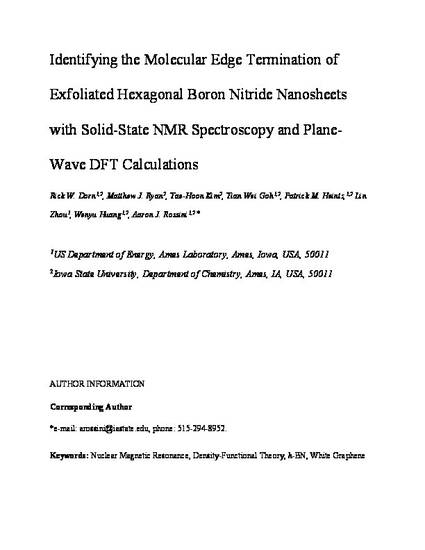
Hexagonal boron nitride nanosheets (h-BNNS), the isoelectronic analog to graphene, have received interest over the past decade due to their high thermal oxidative resistance, high bandgap, catalytic activity, and low cost. The functional groups that terminate boron and nitrogen zigzag and/or armchair edges directly affect their chemical, physical, and electronic properties. However, an understanding of the molecular edge termination present in h-BNNS is lacking. Here, high-resolution magic-angle spinning (MAS) solid-state NMR (SSNMR) spectroscopy, and plane-wave density-functional theory (DFT) calculations are used to determine the molecular edge termination in exfoliated h-BNNS. 1H → 11B cross-polarization MAS (CPMAS) SSNMR spectra of h-BNNS revealed multiple hydroxyl/oxygen coordinated boron edge sites that were not detectable in direct excitation experiments. A dynamic nuclear polarization (DNP)-enhanced 1H → 15N CPMAS spectrum of h-BNNS displayed four distinct 15N resonances while a 2D 1H{14N} dipolar-HMQC spectrum acquired with fast MAS revealed three distinct 14N environments. Plane-wave DFT calculations were used to construct model edge structures and predict the corresponding 11B, 14N and 15N SSNMR spectra. Comparison of the experimental and predicted SSNMR spectra confirms that zigzag and armchair edges with both amine and boron hydroxide/oxide termination are present. The detailed characterization of h-BNNS molecular edge termination will prove useful for many material science applications. The techniques outlined here should also be applicable to understand the molecular edge terminations in other 2D materials.
Available at: http://works.bepress.com/wenyu_huang/60/

This document is the unedited Author’s version of a Submitted Work that was subsequently accepted for publication in Journal of the American Chemical Society copyright © American Chemical Society after peer review. To access the final edited and published work see DOI: 10.1021/acs.chemmater.0c00104. Posted with permission.